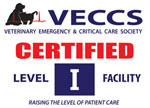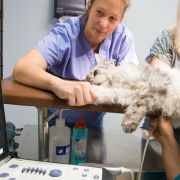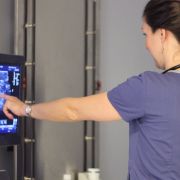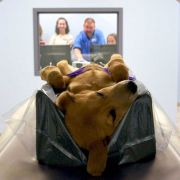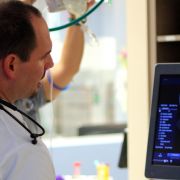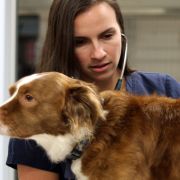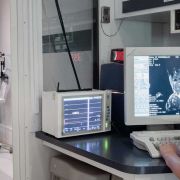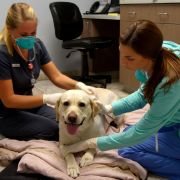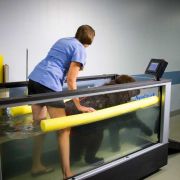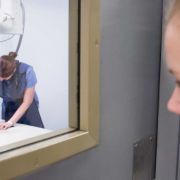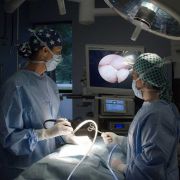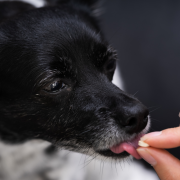Date:
By Alan E. Green with Dr. Jean Frazho
It gives me great pleasure to introduce Dr. Jean Frazho to our Mercury readers. Dr. Frazho is a gifted and talented board certified surgeon and the newest member of our CVRC family.
As veterinarians, one of the most common orthopedic issues we see is rear-leg limping or as we say, lameness. For those of you with working and sporting dogs, understanding the problem and the solution is most critical to the long-term performance of your dogs, and their return to normal function. It is important to appreciate the details of addressing lameness what we in veterinarian circles call cruciate ligament disease and treatment.
An occasional hop, skip or jump may not seem unusual in our pets, but what about holding up a leg or not putting full weight down? All of these changes can actually be signs of a problem. Changes in walking, jumping or playing can all be signs of orthopedic or neurologic problems. In the back legs, one of the most common causes of lameness in dogs and cats is a cranial cruciate ligament tear (same as an ACL tear in people).
There are multiple ligaments that stabilize the knee joint. One of the most important in dogs is the cranial cruciate ligament. Even partial tears in this ligament can cause lameness. In people, ACL tears tend to happen following a trauma like a car accident or a football injury. This can happen in dogs as well, but more frequently there is no trauma and they may only have been walking down the street, jumping on the bed or playing Frisbee at the park. The reason for the different cause of tear is that in people ACL tears are traumatic and more commonly in dogs they are a degenerative process. I imagine it like a rope fraying over time. As the rope frays, your dog (or cat) may limp occasionally and then get better until you reach that day when the last of the ligament tears and then the lameness does not go away as easily.
Because the ligament broke due to a degenerative process, the ligament itself is not healthy and in many cases when we open these joints the ligament has started to “melt away” or be resorbed. Rest alone will not allow an unhealthy ligament to repair itself and we do not expect to ever have a normal cruciate ligament again in that joint. Going back to people, because their tears are traumatic and the ligament IS healthy, they can sometimes rest and the ligament will heal.
Diagnosis of a cruciate tear is generally based on physical examination alone. When vets feel the knee joint, they will try to feel for laxity or looseness to the knee by eliciting manipulative tests called a positive cranial drawer sign and/or tibial thrust which are only felt in dogs with cruciate rupture. In addition, they again feel for supporting changes like extra joint fluid and development of scar tissue on the inside of the knee. X-rays do not show ligament tears because they are good at showing bone but not capable of showing discrete ligaments.
X-rays do help support the diagnosis of a cruciate tear when we see changes like extra fluid in the joint (a sign of inflammation) and development of arthritis and so they are commonly recommended when vets suspect a cruciate tear. In rare cases where a vet highly suspects a partial cranial cruciate ligament tears, but is not feeling the changes on physical exam, other diagnostic options include MRI or knee arthroscopy.
It is important to remember that, in dogs that have been diagnosed with a cranial cruciate rupture, they have about a 50 percent chance of developing the same problem in the opposite knee (don’t worry, they have elbows up front, just like us, so only two chances for rupture).
Treatment for cruciate ligament tears may be broken down into conservative management and surgery. There are several treatment options within these two groups because no one treatment is best for all our pets.
Conservative management includes rest and pain medication/joint supplementation use. With rest we are not trying to heal the ligament (as mentioned above, the ligament is degenerative and not capable of healing normally); we are trying to allow the pet’s body to stabilize itself with its own scar tissue.
Classically people give rest as an option for smaller dogs and cats though this is one of many recommendations open to debate, but the thought is bigger dogs cannot build up enough scar tissue on their own. Rest, or activity restriction, is continued for 6-8 weeks and for patients that have persistent or recurrent lameness after conservative management, surgery would be recommended. In addition, some have tried to add braces to help support the leg and again allow the body to build scar tissue. Rest is always an option and can be tried before surgery. The risk of conservative management is, as we wait, more arthritis can develop and as the weight is shifted to the other leg, there is a chance of speeding/developing ligament rupture in the other leg.
There are several surgical options and all have their own unique pros and cons. The suture surgery is similar to conservative management in that long term we are depending on scar tissue to stabilize the joint. The difference is that we are creating the temporary stabilization with an internal material and can get a much tighter stabilization then just rest and not letting your dog play.
The bone cutting surgeries tibial plateau leveling osteotomy (TPLO) or tibial tuberosity advancement (TTA) seem like a very aggressive approach to a soft tissue/ligament problem, but believe it or not, most dogs are using their legs sooner than with the suture surgery. TPLO has now been around for more than 20 years and results overall have been very successful in regards to return to a high level of function. With TPLO or TTA, surgery does not depend on scar tissue development, but instead by changing the joint anatomy. Once the bone has healed, the new anatomy is “locked in.”
Cruciate ligament rupture is a common cause of limping in the back legs. This is a very treatable problem and there are many treatment options. Discussion with your veterinarian and sometimes referral to a surgeon (like the surgeons here at CVRC) can help you to determine the treatment that best fits your pet.



